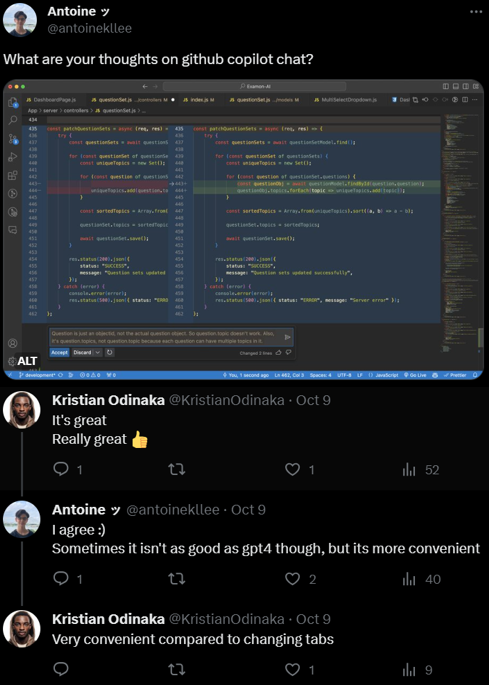
GitHub’s innovative take on modern software development. (Generated with AI)
How GitHub Copilot Chat ensures all your code is clean
- GitHub Copilot Chat offers real-time coding insights, transforming previous practices.
- A study shows GitHub Copilot Chat boosts coding speed by 55% and enhances developer confidence.
- The study involved blind code reviews by fellow coders.
As we approach 2024, the emphasis on impeccable software delivery is intensifying, shifting our focus predominantly to the maintainability and reliability of code.
Modern development teams face unprecedented pressures to consistently produce top-tier software in this era of DevOps and continuous delivery. Clean code stands at the forefront of this challenge, serving as a foundation for smooth, maintainable software processes. This fundamental aspect enhances team collaboration, curtails technical debt, and elevates productivity.
A fresh perspective on coding practices is paramount. A recent study by GitHub on its new “GitHub Copilot Chat” underscores this new reality. Through the adept use of natural language processing, developers receive real-time insights, strategies, and solutions tailored to their unique coding challenges, all within their integrated development environment (IDE). Remarkably, even first-time users of the feature produced quality code with the assistance of GitHub Copilot Chat.
85% of developers expressed enhanced confidence in their coding output when using GitHub Copilot and its Chat feature. Additionally, code reviews became more purposeful and saw a 15% acceleration in completion time with the chat feature in play.
The current landscape: code review evolution and software security
In today’s intricate software development landscape, the evolution of code review is palpable. There’s a growing dependency on automated tools for problem detection. However, despite their value, these tools have limitations and need discerning evaluation by reviewers. Given the burgeoning importance of software security, particularly within web and cloud sectors, code reviews have become indispensable in identifying security gaps and fostering a culture of security vigilance.
The value of diversity and inclusion in the code review process is gaining traction. While the inclusion of varied backgrounds and viewpoints augments team innovation, it’s essential for reviews to be devoid of biases and to offer constructive, inclusive feedback consistently.
Peering into the future, code review seems poised for potential innovations, from AI enhancements to the emergence of novel review techniques. Given the potential for ethical and legal ramifications, reviewers and developers must remain abreast of these evolving trends.
These evolving dynamics underscore why 88% of developers report an uninterrupted workflow state with GitHub Copilot Chat, citing heightened focus and an enriched coding experience.
A GitHub study revealed a 55% acceleration in coding speed among GitHub Copilot users. Speed, however, is just a facet of the process. In some instances, rapid execution has been at odds with precision. This reinforces the significance of superior code quality, especially as AI becomes an integral co-author for an expanding pool of developers.
Defining high-quality code: GitHub’s perspective
In software development, the essence of high-quality code remains paramount. But how do we delineate between exemplary code and code that hinders efficiency? GitHub offers a clear perspective.
GitHub has established a set of five critical metrics, rooted in its internal standards and broader academic and industry benchmarks. These metrics let developers tell the difference between efficient code and impediments in their workflow.
Clarity in code
Clear, legible code is indispensable. Ambiguous or convoluted code can pose challenges in upkeep, enhancement, and documentation, reducing overall productivity.
Emphasize reusability
Assessing code reusability determines whether existing components, such as specific code segments, can be used again. Attributes like modular design or minimal coupling enhance reusability. Interdependencies, which can be identified using static analyzers, play a significant role. Reviewers, too, have the onus of ensuring that the examined code either stands reusable or aligns with already available code.
Adherence to the DRY principle
Code repetition is a pitfall to be avoided. Repetitive segments not only elevate error prospects but also complicate maintenance tasks. Embracing the ‘Don’t Repeat Yourself’ (DRY) principle, developers ought to centralize shared functionalities, eliminating redundancies and forging a streamlined code structure.
Prioritize maintainability
The efficiency with which software can be updated or repaired hinges on its maintainability. Factors like the code’s volume, uniformity, design, and intricacy come into play. Multiple facets contribute to a code’s maintainability, from testability to comprehensibility. A holistic approach, merging automated tools and human evaluation, is essential to engineer maintainable code structures. Instituting an engineering knowledge repository can substantially aid teams in taking in and sharing effective maintainability practices.
Foster resilience
A code’s resilience reflects its ability to sustain operations despite potential glitches. Ensuring such robustness is pivotal for any code to function seamlessly, or with negligible disruptions, under unforeseen scenarios.

Users have mixed opinions regarding the GitHub Copilot Chat. (Source – X)
How GitHub set up the study with GitHub Copilot Chat
The study aimed to recreate a controlled environment where participants would draft code, undergo a code review, and then implement the suggestions from that review. Each participant was tasked with writing code, evaluating code, and then acting on the feedback from the code review.
GitHub enlisted 36 participants, all of whom had software development experience ranging from five to ten years. Throughout the study, these participants wrote and assessed code with and without the assistance of GitHub Copilot Chat. Their task was to script API endpoints for an HTTP service that performs create, read, and delete functions on objects. Randomly, some were directed to use GitHub Copilot Chat for this task.
Before they began, they were shown a short tutorial video about GitHub Copilot Chat. Their work on creating the API endpoint resulted in one pull request, and another was made for the read and delete functions.
Once the API endpoint code was written, participants evaluated the influence of GitHub Copilot Chat on the caliber of their work. They were questioned on whether the tool made the task simpler, whether the resulting code had fewer mistakes, and if it was more readable, concise, reusable, durable, and robust.
Post-writing, developers were handed two pull requests scripted by another study participant for review. These developers were unaware of whether the pull requests were written using Copilot. They were instructed to review and offer improvement suggestions. Afterwards, they assessed the review process with and without GitHub Copilot Chat, evaluating the code’s readability, reusability, and architecture.
Lastly, after receiving reviews from their peers, the original code authors went through the feedback on their pull requests. Their aim was to determine the value and practicability of the comments. They remained uninformed about which feedback was provided with the assistance of Copilot Chat.
READ MORE
- Safer Automation: How Sophic and Firmus Succeeded in Malaysia with MDEC’s Support
- Privilege granted, not gained: Intelligent authorization for enhanced infrastructure productivity
- Low-Code produces the Proof-of-Possibilities
- New Wearables Enable Staff to Work Faster and Safer
- Experts weigh in on Oracle’s departure from adland




